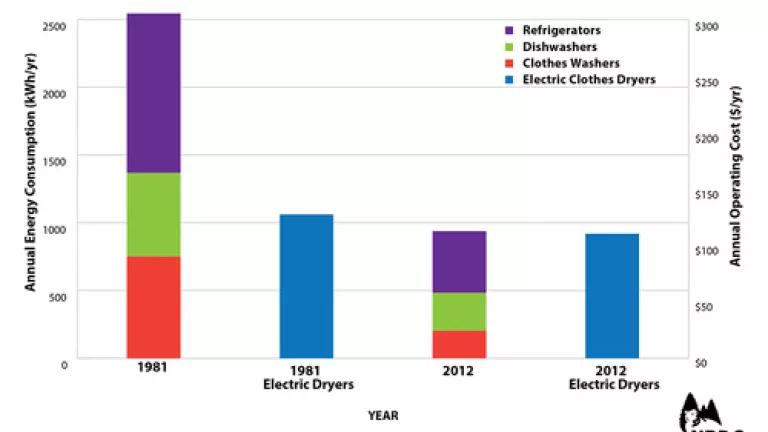Call to Action: Make Clothes Dryers More Energy-Efficient to Save Consumers Up to $4 Billion

NRDC is releasing a Call to Action today to help reduce the $9 billion worth of energy used by our clothes dryers, which few people realize are one of the largest energy users in our homes and represent 2 percent of our nation’s entire electricity consumption.
While major appliances like air conditioners, refrigerators, and even clothes washers have undergone significant energy efficiency improvements during the past 20 years, unfortunately the amount of energy wasted by clothes dryers in the United States has received little attention.
As this graph shows, a typical electric clothes dryer often consumes as much energy annually as a new refrigerator, clothes washer and dishwasher combined.
While dryer energy use has remained essentially unchanged in the United States, the good news is dramatically more efficient models exist in Europe, Australia, and Asia – demonstrating that the technology exists to cut dryers’ energy waste.
In fact, extensive research done by NRDC and its consultant Ecova shows that updating residential dryers to the level of the most efficient versions sold overseas could save U.S. consumers a whopping $4 billion a year. These improvements also would prevent roughly 16 million tons of carbon dioxide emissions annually, equivalent to the pollution from three coal-fired power plants.
Other key findings from our report include:
- There are 89 million residential clothes dryers in the United States (75 percent electric models, 25 percent natural gas). Although electric dryers dominate the U.S. market, natural gas dryers typically cost 50 percent to 75 percent less to operate.
- A typical household pays over $100 in annual utility bills to operate an electric dryer and $40 for a gas dryer. Homes with electric dryers pay at least $1,500 over the dryer’s lifetime for the electricity to power the machine.
- Some dryers on the market today have poorly designed auto termination sensors, meaning those models continue to run (and waste energy) for up to 20 minutes after the clothes are dry.
- The EPA has just added dryers to its ENERGY STAR™ labelling program. Models meeting ENERGY STAR requirements will use up to 20 percent less energy than versions that simply conform to the federal energy efficiency standards. The upgraded models will be available within the next few months.
- Almost 70 percent of dryers are sold in matching combinations with washers. While energy saving standards have steadily improved for washers due to utility incentives, labeling programs and federal standard, dryers have lagged behind. As a result, manufacturers have less incentive to improve the energy-savings for dryers as that’s where they can make the most profit from the pair.
- The test method used by the Department of Energy to measure the energy consumption of clothes dryers needs additional revision as it uses non-real world loads. Currently dryers are evaluated by using a set of uniform thin test cloths rather than actual clothing like blue jeans and towels, which may require longer drying times. This can result in a significant underreporting of dryer energy use and operating costs.
Utilities and other agencies can play a key role in pulling to the U.S. market the next generation of more efficient clothes dryers that incorporate some of the technologies available overseas. Availability of these better dryers at outlets like Home Depot and Sears will help pave the way for DOE to dramatically tighten its dryer efficiency standards to reflect available technology for the next update due in 2017.
While the exterior of clothes dryers have become more attractive, the insides are very much in need of a makeover. Let’s hope our “Call to Action” helps jumpstart the race toward better clothes dryers and lower utility bills for consumers.
|
Tips to reduce laundry energy use and electric bills until dryers become more energy-efficient: 1. Wash your clothes in cold water and save up to 50 cents a load. Today's washers and detergents do a good job cleaning clothes in cold water and there is no reason to use hot water except for the dirtiest of loads. 2. Select the highest spin speed available when washing clothes. High spin speeds on front-load washers remove a lot more moisture, reducing the time and energy needed to dry clothing. 3. When shopping for a new washer or dryer look for one with the ENERGY STAR™ label. ENERGY STAR-labelled models will use up to 20% less energy and save consumers lots of money over the dryer’s typical 15-year lifetime. 4. Buy gas instead of electric. Until dramatically more efficient electric dryers become available, consumers should buy gas dryers whenever gas hook-ups are available in the home. |
